How to Develop a Doctor Appointment Booking System
19 min read
Page Content
- 1. Doctor Appointment Apps Market Overview
- 2. Why Should You Build an App for Booking Doctor Appointments?
- 3. Top 4 Doctor Appointment Booking Apps
- 4. Key Features of Doctor Appointment Mobile App
- 5. How Does an On-demand Doctor App Make Money?
- 6. 8 Steps of Doctor Appointment App Development
- 7. Doctor Booking App Development Cost
- 8. Codempire Experience in Design and Development of Online Doctor Appointment System
- 9. Conclusion
Doctor Appointment Apps Market Overview
Today, the application for a doctor appointment market is estimated at approximately 38 billion. It is expected that by 2026 this amount will exceed $168 billion.
Such a surge in the popularity of online doctor appointment app development is due to the COVID-19 pandemic.
Remote consultation, different languages, and the possibility to subscribe under your travel insurance open another, post COVID page of Doctor Appointment Apps Opportunities for business and for tech geeks.
More than 80% of people using the healthcare appointment app reported that they started doing so after the pandemic.
And this trend is sustainable - 43% of adults surveyed started using online doctor apps after the end of the pandemic.
So you can be sure of the relevance of doctor appointment application development.
Looking for an opportunity for your startup in this field, or thinking about your hospital service improvement? Please reveal in our article tips, costs, business models, and some benchmarking information on doctor appointment booking system development.
Why Should You Build an App for Booking Doctor Appointments?
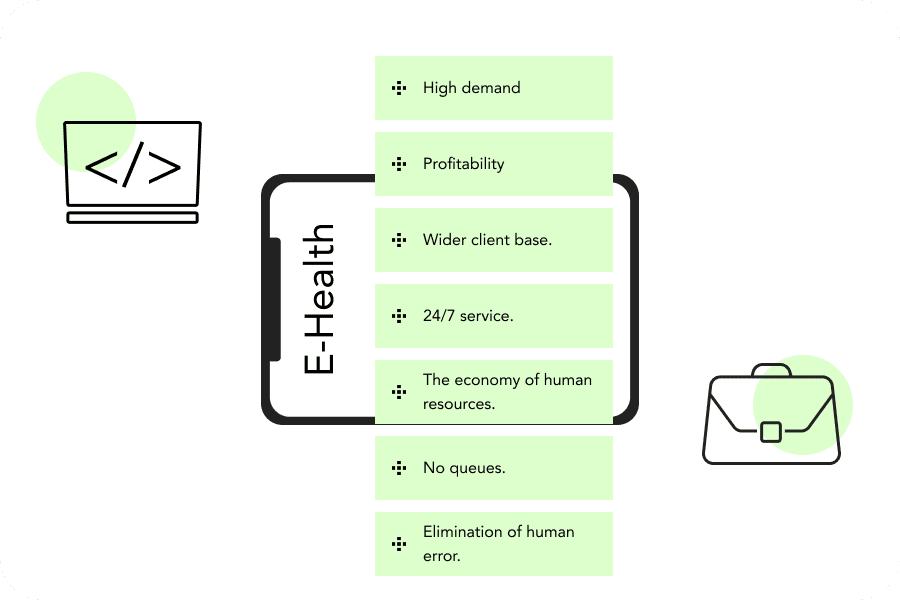
The most popular areas of the online healthcare industry can divide into two groups:
- Software for hospitals.
72% of people search for information about medical services online, and more than 60% choose a doctor online, including reading reviews.
Over the past six months, the percentage of electronic prescription app users has increased by more than, 65000%. Can you imagine how many times the availability of software increases the competitiveness of your healthcare business?
- M-health.
Every third adult suffers from some chronic disease.
Digitalization of health care help patients to monitor health constantly and affordably. It causes m-health products’ popularity - particularly, mental health applications have about 2 billion users.
In terms of profitability, the Mobile healthcare industry in 2020 in the United States received the largest amount of investment (namely almost 1.8 billion).
If you are a vendor
High demand. The survey said that 42% of respondents prefer online booking. As expected, it encourages almost 80% of healthcare providers to use reception management services.
Profitability. Do you still find that creating an app to make a doctor’s appointment is a questionable idea? Then here are some simple statistics: the design and development of an online doctor appointment system have a profit margin of 25%! And sales of services and licensing can bring even more - 35% and 26%.
And we can see confirmation of this data. A study dated 2020 states that users spent 50 billion on health-related applications. By 2023, this figure is expected to increase to more than 900 billion - namely 18 times.
If you are healthcare business owner
Wider client base. According to statistics, 68% of people prefer medical facilities that provide online booking services. The telemedicine feature is close to this indicator, in particular in the field of mental health. According to a 2021 study, 59% of Americans prefer telehealth services for psychotherapy and counselling.
24/7 service. Clients can book/cancel/reschedule appointments at any convenient time, and you don’t need to hire 24/7 staff to do this. More than 30% of appointment bookings make during non-working hours through the clinic appointment app.
The economy of human resources. Create a doctor appointment app - mean give patients the opportunity to take care of records management, and take all the necessary data, and medical reports automatically through an app. It significantly saves working hours.
No queues. It’s vital in pandemic circumstances that the automation of medical services eliminates the need for patients to queue at the reception, creating unfavorable covid conditions.
Elimination of human error. Since the appointment scheduling is automated, there is no chance that the operator will make a mistake, which will cause a waste of time and money for doctors, the patient, and the hospital in general.
Top 4 Doctor Appointment Booking Apps
Zocdoc
This world-renowned application began its journey as a startup for Manhattan dentists in New York in 2007.
In 2008, the project began to receive millions of investments, which helped it grow into a large project, which had covered 40% of the market in 2,000 cities across America in 2014.
In 2020, under the pandemic influence, product owners launched a telemedicine function.
The monetization model of this app includes a subscription fee (for doctors and clinics), a fee for each booking, and paid listing (the ability for doctors to use marketing tools to promote rankings). Patients can use this platform for free.
Today Zocdoc has 6+ Mln monthly active users, and offers them:
- 1800 types of medical services;
- online reception management with a notification system;
- 50+ categories of specialists;
- reviews and ratings of doctors based on patient assessments;
- telemedicine for real-time communication with a doctor online or an appointment for an offline visit.
MFine
The history of MFine began with the fact that the top managers of the large-scale e-commerce project Myntra decided to develop a doctor appointment app for the Indian market.
The project was founded in 2017 as an m-health platform. Nowadays, it covers 1,000 Indian cities.
Unlike Zocdoc, MFine cooperates not with individual doctors but with medical institutions.
The main emphasis is on artificial intelligence and the Internet of Things for chronic disease treatment with the ability to connect medical equipment. These all make the app a perfect tool for clinics to digitize their services.
MFine currently works with 700 clinics and can offer patients 6,000 doctors in 35 medical specialities. Users can manage appointments via chat or voice booking and get medical consultations in person or through telemedicine.
MFine earns revenue by charging a fee for booked visits and lead generation
Practo
It is a healthcare platform providing services to users from India and Singapore.
Its history began in 2008 with the creation of the Turbodoc application. It got its current name two years later. The platform is positioned as an independent unbiased app for patients, which allows you to find a doctor, manage appointments, search for laboratories, order meds, and store health data. This app can work as a tool for hospitals for digitizing services and automating processes.
Practo provides profitability through a licensing fee - as a Software-as-a-Service available by subscription.
The service covers more than three hundred cities across India, and more than 30,000 bookings are made through it every month.
Both doctors and patients can use the application for free. However, there are also two advanced service packages at an additional cost: the CM Atom plan for Rs 999 and the Clinic Management plan for Rs 1999.
Doctor On Demand
This service for finding doctors dates back to San Francisco in 2012.
Today, 98 million Americans use this application.
Its users have access to 24/7 access to medical care online, e-prescriptions, telemedicine, storage of material records, and the possibility to use insurance.
The service receives income from patients who pay for themselves or with the help of an insurance company. Also, a fee is charged for each booked reception. The usual price for a 15-minute standard physician’s appointment will cost the patient $75 - if it is a treatment for somatic problems. The price of a psychotherapist’s consultation is $129 for a 25 min consultation and $179 for a 50 min consultation. Psychiatrist services will be the most expensive: $299 for 45 min consultation and $129 for 15 min follow-up.
To learn more about financial information, you can refer to the table below and compare the data of these four companies.
| Zocdoc | MFine | Practo | Doctor On Demand | |
|---|---|---|---|---|
| Revenue | $136 Mln | $44 Mln | $39 Mln | $33.63 Mln |
| Total Funding | $377 Mln | $97.6 Mln | $251.2 Mln | $235.7 Mln |
| Valuation | $2 Bln | $277 Mln | $300-310 Mln | $820 Mln |
| Monetization model | subscription fee, paid listing |
comission-based | comission-based, subscription fee, advertisement |
comission-based |
| Doctors | 47,363 | 6000 | 1,20,000 | 1500+ |
| Downloads | 1,000,000+ | 5 000 000+ | 5,000,000+ | 1,000,000+ |
Want to repeat the success story of Zocdoc or Practo?
Just write to us and get the most valuable business advice from the professional development team!
Contact usKey Features of Doctor Appointment Mobile App
Users’ profiles
For the doctor
The doctor’s account must include a photo and basic information about education, accreditation, specialization, licenses, and experience. There should also be an appointment button, and it will be great, especially if the patient can calculate the approximate cost of the appointment/treatment in advance.
For the patient
The patient should have access to his medical records, research results, treatment plan and anamnesis. Equip his profile with the ability to fill in the personal data, contact and medical information, treatment and appointment planning features.
Searching engine with advanced features
If you create a doctor search app with a large client base, include an item on the advanced search process implementation in the on-demand doctor app development plan. Provide the user with a custom search function by category, location, medical facilities, names of specialists, types of medical services, or health problems. You can add filters by price, popularity, number/percentage of positive reviews, and date.
It will help the specialist and the patient search for each other more respectively, which will affect both the loyalty of your users and profits.
Appointment management
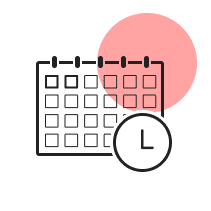
Calendar, reminders, push notifications - use these features to automate appointment management. So your client will not only be able to make an appointment or cancel/reschedule an appointment at any convenient time but will also be aware of planned studies, examinations, and free time slots. It’s also useful for doctors and clinics to minimize the waste of time due to canceled or rescheduled sessions.
Community
Equip the application with chats so that doctors can communicate with patients, share third-party materials, ask and resolve questions, clarify information misunderstood or misunderstood during the appointment, and resolve organizational issues without the need to schedule a separate session.
E-prescriptions
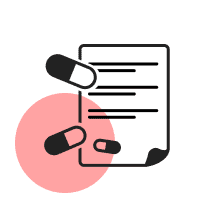
It will make life easier for both medical staff, who will not have to spend time writing prescriptions, and patients. They won’t have to visit a doctor/clinic to get a prescription and can have it with them - on their smartphone - when they need to buy medicine. World practice shows that the transition to e-prescriptions is already underway. For example, in the United States, in 2020, more than 80% of prescriptions were already electronic.
Payment module
You need to provide users with comfortable payment methods: linking bank cards, e-wallets, online banking, and various currencies. But in addition to comfort, think about safety. One of the most common secure options is a payment gateway. In addition to paying for services as a customer, you can use this tool to receive payment for advertising/promotion. For example, to implement a paid listing monetization model.
Telemedicine

69% of patients using online patient appointment do so via video conferencing tools instead of regular phone calls.
So the telemedicine function is a definite must-have in a doctor appointment booking system development. It can be implemented by developing your custom tools or integrating existing solutions, such as ZOOM and Google Meets.
How Does an On-demand Doctor App Make Money?
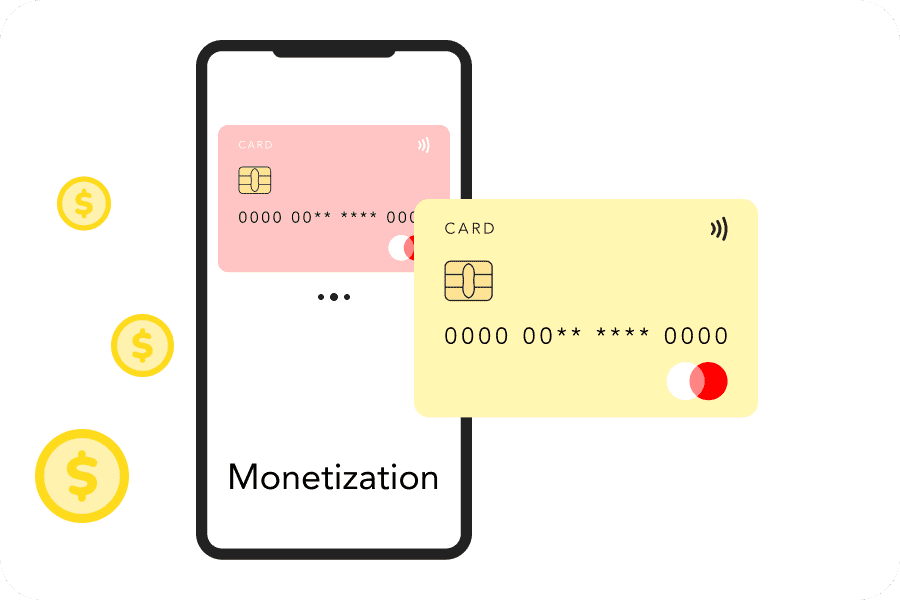
Commission-Based Model
This model is quite simple: the medical supplement is paid in the form of a commission for each paid medical appointment. Applications can also charge for generating new clients (such as MFine).
Paid Listing
This model works through marketing tools that allow you to promote certain doctors to the top of the list when searching by category.
Subscription fee
Here, the client pays for the subscription to the medical consultation app regularly. If you are planning to build an app for booking doctor appointments on this business model, keep in mind that there are patient-oriented and doctor-oriented resources. The former is free for the end-user, and doctors pay. In the second case, the opposite is true. You can also use this model in a slightly different way - to offer an advanced version with additional app features for a paid subscription for both doctors and clients.
Advertisement
With this model, you can earn money from advertisers and also offer the use of your health care application without advertising for an additional fee.
Market analysis, budgeting, and monetization - our team knows how to avoid all the pitfalls from their own experience.
Let's make a call, so they'll happily share all the knowledge!
Contact us8 Steps of Doctor Appointment App Development
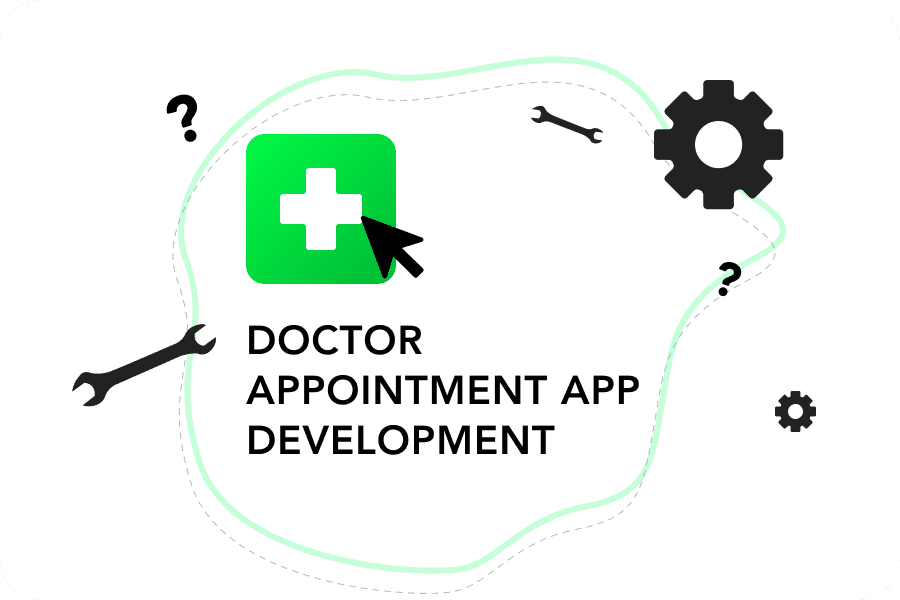
Detailed analysis
You need to know everything about customers, market, and rivals. Surveys of potential users should include as many categories as possible to be representative.
As for the market and competitors, you’ll need statistics, and it will be great to look at the market leaders - test their products, and read the reviews. Find their strengths and weaknesses to understand development areas for your application.
For self-analysis, you can use such services as Statista and Google Analytics.
But it’s better to turn to professional discovery teams. Some software developer firms provide related consulting services. It’s a great option because such specialists have encountered on-demand doctor appointment app development in a personal experience, so they can provide unique information, even tailored to your specific business idea.
Choosing technical partner
When searching for a healthcare software development services, you should pay attention to the following criteria:
- Experience. To ensure the company’s expertise, check the portfolio, make an organizational call, see examples of ready-made projects, and read other customers’ reviews (it’s better to prefer independent sources such as CLUTCH).
- Terms of cooperation. A reliable company will offer you transparent cooperation terms and in several variations. Clarity, simplicity, and detailed discussion of all organizational aspects - are the main features of an experienced, professional, responsible, and honest team.
- Outsourcing. Take a look at this option. Here, the outsourcing development company takes full responsibility for the team setting, the organization of communication and work process, as well as delays. You don’t have to worry about things like equipment or office rent. On the other hand, development costs are relatively low if you choose a company from Eastern Europe, for example, where the level of education and professionalism is quite high, and ratings are relatively low due to the lack of large-scale projects in the local market. In addition, a well-coordinated team will work on your project on clear terms and with deadlines, which would not be so easy to organize when hiring freelancers.
Planning: budget, technology, methodology, team
At this stage there is detailed planning:
- Budgeting, team setting, and choosing a tech stack. These things are directly related. A well-thought-out stack for the project will help optimize the cost of doctor on-demand app development and working resources. So, by choosing React/React Native Stack, you’ll spend 30% less money on hybrid development than in the case of native development. In addition, you can build an app simultaneously on both platforms (iOS and Android). And thanks to flexibility and simplicity, these technologies allow virtually unlimited scaling and modification of the application. Not surprisingly, 40% of projects are built using React, and it’s the highest figure among frameworks.
- Features. It’s necessary to determine the feature set and divide all functions into key and additional ones. The first will implement primarily at the MVP stage, and the rest - later during the iterations of the Build-Measure-Learn cycle.
- Methodology. In practice, we have identified the best methodology - Agile, which we use with the Scrum approach. This combination gives an excellent performance and provides simplicity and high development speed. Statistics confirm that this is indeed one of the best methodologies. Thus, 71% of projects in the US are made with the help of Agile. In 94% of cases, this technology is combined with Scrum.
Design creation and prototyping
At this stage, UI/UX specialists create a prototype of the future application. Why do you need it?
- Concretization of goals and objectives. With the finished design, the team will have something to start from, and it will be easier to divide the workload into parts.
- Ability to anticipate difficulties and avoid them when building software.
Increasing investment prospects - having a rough idea of the project, investors are more willing to invest in it.
Development and testing process
Scrum Agile methodology involves the organization of the development process for sprints. Each new sprint begins only after planning, implementation, analysis, and approval of the previous one by the product owner. In this way, the application owner retains control over the process and avoids confusion, because the application is building consistently. It also provides timeline benefits. The detailed division of work into stages - milestones with clearly defined deadlines for each one is more accurate to calculate the implementation timeline and establish clear areas of responsibility for delays between team members.
A significant part of development is testing. Carrying out testing on each milestone will give you quality assurance and solve possible problems in advance.
Deployment
At the deployment stage, it’s vital to ensure uninterrupted communication and timely updates of changes with product-owner notification to achieve rapid product launch. CI / CD technology will be the perfect tool for this.
Post Launch support
Doctor appointment mobile app development doesn’t end after the product launch. Сonversely, once the MVP is ready and you receive the first revenue and feedback, it gives you an incentive for further improvement. During the Build-Measure-Learn cycle, you collect, analyze user feedback, plan for application improvements, implement changes, and start a new iteration. As a result, by minimizing financial risks, you’ll gradually improve your product while maintaining complete control over the process.
Doctor Booking App Development Cost
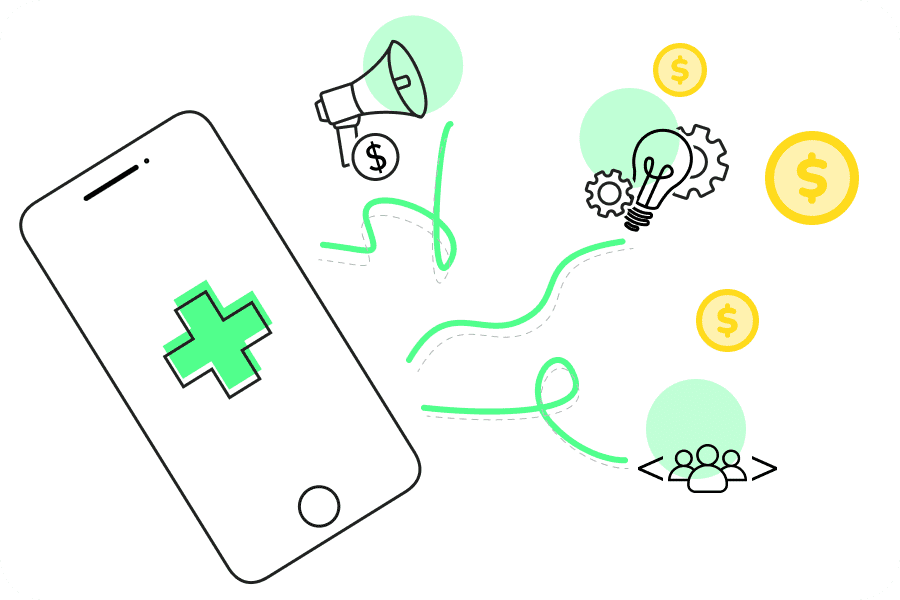
On average, an application for online medical booking costs from $15,000 to $40,000. But these are average figures for small or medium-sized projects. The final project cost can reach a million dollars - there is no final maximum mark. It all depends on various factors, which we’ll discuss below.
Complexity level
Doctor booking app development cost directly depends on the complexity and scale of the project. Yes, a small app for booking receptions can be developed in 2-3 months, spending $15,000- $30,000.
If you are interested in a more complex idea, it will take much more time and time - at least six months and $50,000.
For this price, you can get, for example, a chat app with the function of voice booking of receptions using a bot, or an application with electronic prescriptions, storage of patients’ personal data, and medical history analysis.
And the most expensive will be the apps such as Zocdoc, which uses machine learning and artificial intelligence. Its development takes more than one year and continues relentlessly, respectively, and its price continues to rise.
Development team
Hiring a team yourself, maintaining an office, and purchasing equipment will significantly increase the cost to develop your application.
It’s much more profitable to work with freelancers. This option, unfortunately, doesn’t eliminate the need to participate in the organization of work and doesn’t provide reliable guarantees of quality software development, clarity of deadlines, and coherence of communication. But you can turn to outsourcing companies. When choosing them, pay attention to localization. The rates of developers from Western Europe and the United States are the highest in the world, ranging from $65 to $130. While engineers from Eastern Europe aren’t inferior to them in terms of service quality. The relatively low rates of local specialists (namely $30–$65) are due to the lack of large-scale local projects, as well as lower prices for office maintenance than in the United States.
Codempire is the company that can provide you with a perfect price-quality ratio and transparent cooperation terms.
Smart bugging, selecting the perfect technology stack, hybrid development on two platforms, 100% data security, perfectly established communication, responsibility, and timeliness - all these, our company provides to customers, making their business stories successful.
Marketing cost
At the time of 2020, more than 350,000 healthcare applications were available to users, and 83% of them were downloaded less than 5,000 times, while the vast of downloads fell on the most famous and popular applications.
Therefore, to ensure the visibility of your application, order a promotion on social networks, other applications, and web resources. Set aside about $10,000 for this purpose.
Want to calculate development budget and hidden costs of your appointment booking app?
Get professional estimates and budget optimization tips for free!
Contact usCodempire Experience in Design and Development of Online Doctor Appointment System
Ghaya Care
Our customer was a Dubai company specializing in-home care for patients.
The idea was to create an application to find services from professional nurses, including regularly.
The main challenge was to provide a high level of service. It was necessary to equip the application with the ability to collect feedback and respond to it.
The application was created by two engineers using React Native stack.
For the server part, we used Firebase.
Implementation was completed in 3 months, without delays and problems - thanks to the well-established communication and Scrum Agile methodology.
Thanks to the hybrid development method, the client saved about 30% of finances compared to native development.
Now Ghaya Care has more than 500 satisfied customers who have the opportunity to evaluate the service on a five-point scale, leave feedback, adjust the schedule of staff visits, and change the employee as needed.
Tumedico
Our Bolivian technical partner wanted to build a doctor appointment app. The main task was to provide users with the opportunity to receive consultations and treatment remotely. This on-call app was to become one of the few solutions in the Bolivian market and solve the problem of the availability of medical services under quarantine restrictions.
- We have assembled a team of 4 engineers who created the app to book a doctor’s appointment using technologies React.js, TypeScript, Node.js, and Nest.js.
- We chose MongoDB as a database and AWS - for cloud storage.
- The application has a telemedicine feature (through integration with Zoom), an advanced search engine (with location, clinics, doctors, and specialties filters), online booking, and management appointments.
- Tumedico app has launched successfully, and now it has more than 500 registered doctors.
More than 5,000 hours of online consultations have been carried out through the app.
Product-owner increased the number of customers by 30% thanks to our software.
Conclusion
M-health projects are a rapidly developing and profitable field. About 80% of healthcare businesses currently use medical staff scheduling software, and the market estimates at 38 billion.
The doctor appointment booking app development brings benefits to both healthcare business owners and software vendors. For the business owners, it increases customer loyalty, increases their number, and optimizes costs (by reducing the number of canceled receptions and saving working resources through automation). For vendors, it provides access to a large market with high demand for such products. In addition, healthcare mobile development brings 25% of profitability and licensing of the finished product - up to 35%.
Project monetization can be carried through commission-based, subscription fee models, paid listing, and advertising. These models can be slightly modified and combined.
The total cost of developing a doctor appointment app varies from $15,000 to $40,000, depending on the complexity, project scale, engineers’ rates, and marketing cost (which average price is $10,000).
The Codempire team has built its expertise on the experience of successful healthcare projects so that we can follow your idea from the introductory consultation stage to the post-launch improvement.
#healthcare
#MVP